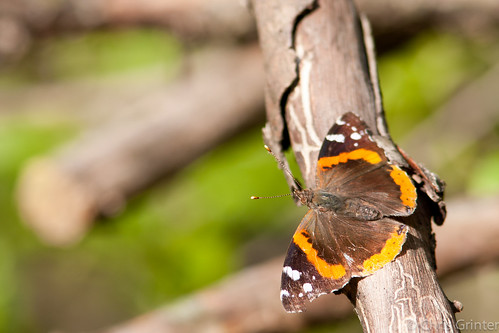Y newyddion lleol ar gyfer y rhan fwyaf o'r dwyreiniol Unol Daleithiau a Chanada wedi bod aflutter (Mae gan) recently with reports of the irruption of Vanessa atalanta – glöyn Fantell Goch. Er bod hyn yn ddigwyddiad cyffredin bob gwanwyn i ieir bach yr haf yma i symud i'r gogledd oddi wrth eu tiroedd gaeafu yn ne yr Unol Daleithiau, mae'r niferoedd aruthrol eleni yn syfrdanol. Yn llythrennol, mae miloedd o lyngeswyr yn ein buarthau cefn.
Felly beth sy'n wahanol eleni?
Mae llawer o ddyfalu am dywydd cynnes y gwanwyn (Mawrth cynhesaf ar gofnod mewn sawl man) ac yn aml llawer o wybodaeth anghywir i gyd-fynd â rhywfaint o entomoleg cadair freichiau. Mae'r rhan fwyaf o'r ffynonellau newyddion rydw i wedi dod ar eu traws yn dweud bod y gwanwyn cynnes wedi caniatáu i'r glöynnod byw hyn ffynnu ac atgynhyrchu mewn niferoedd annormal. Nid yw hynny'n gwbl bosibl fodd bynnag, V. atalanta overwinters as an adult. The southern states provide temps just warm enough for adult Vanessa butterflies to hide in the fall and be the very first to awaken in the spring to get a jump start on mating. Hyd yn oed os oedd y glöynnod byw yn effro ym mis Chwefror nid oedd y planhigion cynnal wedi codi eto (ysgall); mae'r glöynnod byw yn ein iardiau cefn o'r llynedd.
Ond beth petai'r tywydd yn chwarae rhan yn y cylch ffyniant hwn? Roedd y llynedd yn flwyddyn La Niña gyda'n gaeaf hyfryd a mwyn. Y flwyddyn o'r blaen oedd El Niño, most of the eastern US was assaulted with winter and we suffered at the hands of the epic Chicago “snowpocalypse”. Efallai bod y cyfuniad hwn wedi lleihau niferoedd y boblogaeth yn ddigonol 2010/2011 a oedd wedyn yn lleihau llwyth parasitoid, gan ganiatáu ar gyfer mwy o ffrwythlondeb glöynnod byw yn ystod haf 2011. Yna rhoddwyd gaeaf cynnes i'r glöynnod byw hynny a oedd yn gaeafu a allai fod wedi caniatáu ar gyfer llai o farwolaethau yn y gaeaf. As the butterflies moved north this spring there were no frosty nights to cut into populations – just lots of hungry birds. Y canlyniad fyddai mewnlifiad annormal o ieir bach yr haf mudol.
But then again…
Despite butterflies being so popular and well studied there doesn’t seem to be a perfect grip on what conditions each of the Vanessa species prefer. Newidynnau planhigion lletyol, ystod poblogaeth, tywydd a pharasitoidau i gyd yn chwarae rhan bwysig o ran helaethrwydd a dosbarthiad. Did the weather cycles of the last few years variably effect one species over another? Pwy sydd eisiau'r prosiect PhD hwnnw (rhag uffern)?
One of the best posts I’ve read is by Doug Taron over on Gossamer Tapestri – he is skeptical of this warm weather theory. Critically this irruption is effecting only the population of the Red Admiral and any theory involving weather would also likely effect other migrant butterflies like the Vanessa virginiensis – the American Lady. He also points out that an abundant butterfly like the admiral has classic cyclical population booms and busts in sync with parasite populations. I recall another summer in the late 90’s of staggering Admiral populations. Parasites really do better explain what we see in our yards this spring. While the weather might not have caused the abundance of V. atalanta, there can be no denying that butterflies of all species have woken up much earlier this year.



As far as I recall, almost all temperate zone animals (and plants, Yr wyf yn amau) go thru boom and bust cycles. It’s pretty much the function/nature of the wildly variable environmental conditions of the ecosystems. Even the less common temperate zone species cycle but the effects are less noticed simply because of the lower population levels.
must have been a lovely sight, vanessa atlanta has been struggling in the UK for the past few years!!
A few years back you may have heard about the painted lady invasion in the UK very much the same as the USA i was counting well over 1000 an hour coming up the field from the english channel !
Quick question about la nina i believe the later part of 2010 was also la nina thats why the UK and northern USA had such cold weather